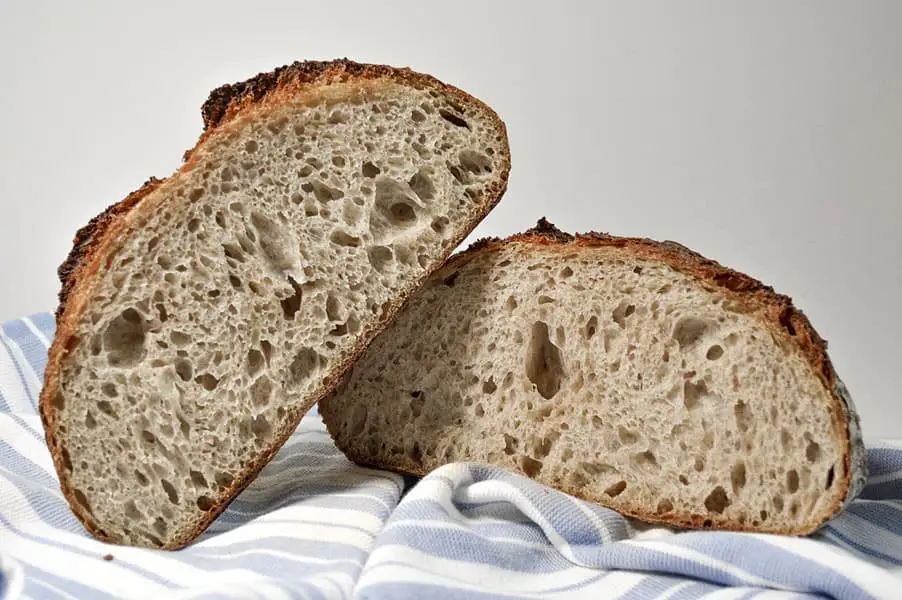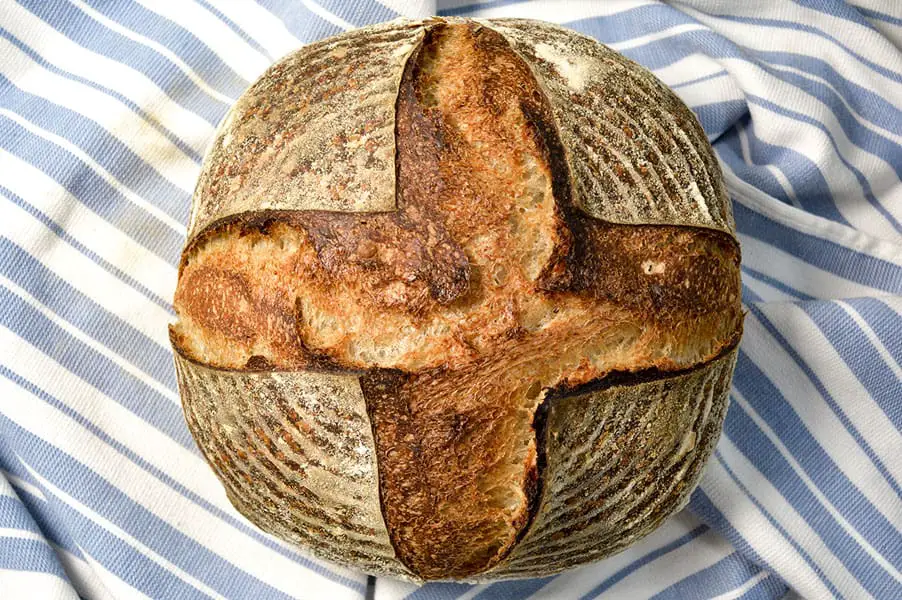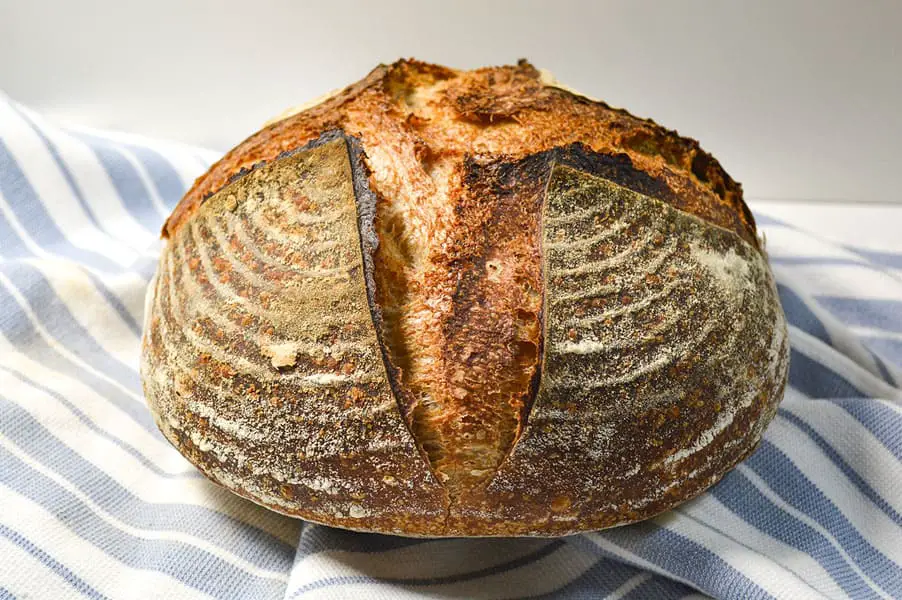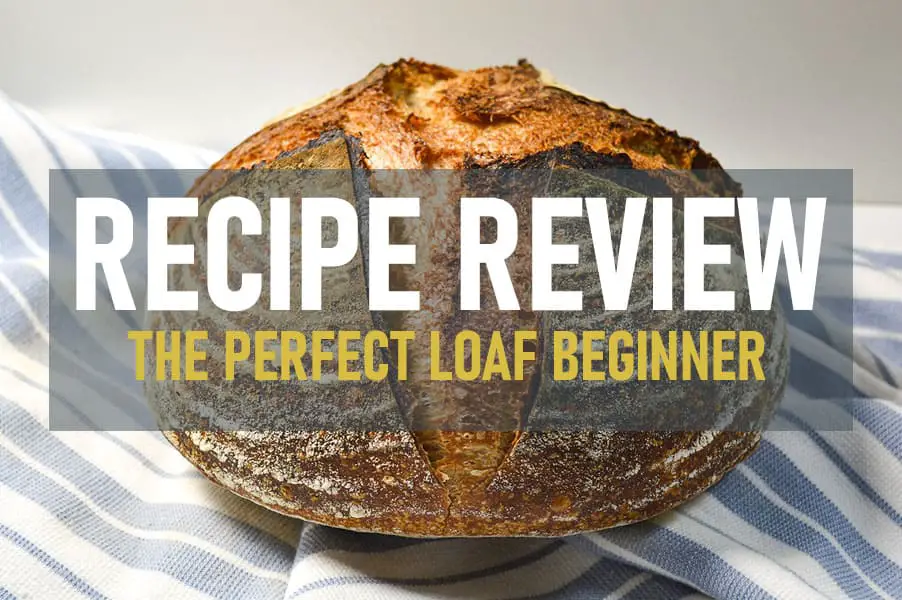Description
At first glance, The Perfect Loaf’s “Beginner’s Sourdough” recipe is a fairly standard sourdough recipe. It builds the levain in the morning, and then moves on through the usual steps – autolyse, bulk ferment/folds, bench rest, shape, overnight proof, and bake the next morning. The whole process takes a little over 24 hours.
What makes this recipe stand out from others is the intense amount of detail included. It’s not so much a recipe as it is a manual. It begins with a table of contents and multiple-page definition of baking terms before going on to describe essentials such as the tools that will be needed, importance of temperature, and recommended types of flour to use.
The recipe portion is no less detailed. Each step is described not only in terms of exactly what is to be done, but also in terms of the time frame (for example, Levain – 8:00 am; Autolyse – 12:00 pm, etc). The amounts and ingredients are clearly listed at the point that they are incorporated into the recipe. A detailed folding technique is included. And the recipe ends with a summary of the expected end results.
The final aspect of this recipe that’s somewhat unusual is the dough hydration. While it’s not uncommon for rustic sourdough loaves to be 75% hydration or higher, this one has been brought down to 72%. This, combined with the depth of instructions, makes it an extremely approachable recipe for those who are new to sourdough.
The Process

For the most part, the intense amount of detail and description made this recipe a dream to follow. I cannot emphasize that point enough. Even with a bit of experience under my belt, there are still many times when following a recipe that I’m not exactly sure what to do. Not so here. There was never a point when I was in doubt about what to do or look for.
However, I do think there are two aspects of this recipe that we’d like to talk about a bit, to help inform beginner bakers approaching this recipe.
The first is that it doesn’t list feeding your starter as a distinct, first step. Instead, the first step is to build the levain, which requires 38 grams of mature sourdough starter. Which means that the starter already needed to be fed 6 – 8 hours previously. Perhaps the assumption is that everyone knows you wouldn’t start a recipe with unripe starter, so of course you need to feed it several hours prior to beginning the recipe.
But since a) there are recipes that call for unfed starter, and b) this recipe is geared for beginners, you might want to think about feeding your starter as a kind of step 1a and creating your levain as a step 1b. Given the amount of detail in this guide, it actually caught us by surprise.
Maybe that is the case because we are in the “bake with unfed starter” camp, and our starter wasn’t mature on the day we set out to make this recipe the first time. For whatever reasons, we simply missed the “mature” starter part as we read through it. Which is why we would have liked to have seen feeding our starter listed as step one.
The second part we’d like to just address for the beginner is the ingredient suggestions. Not only was the type of flour suggested (which we loved), but the brand was listed as well. Don’t get us wrong, we really like the brand suggested, we have great results with it. But we also have great results with several other brands. The brand suggested here is pricier than most common brands and not available everywhere.
It’s not a deal-breaker by any means. It’s just a personal preference of ours (so take it with a grain of salt) not to make beginner recipes that have barriers to entry with ingredients. We would have liked to have seen a concession made for other brands of flour.
Additionally, because we reviewed this during 2020, and flour is still pretty scarce in many regions, we struggled to find rye flour (we don’t bake with it enough to keep it on hand). We had to visit several stores and call a couple of specialty food shops before tracking down rye flour. Thankfully it was the brand the recipe suggested.
But, if it wasn’t for wanting to give the recipe a fair shot we would not have gone through the trouble to track down rye flour for a beginner sourdough recipe.
After making this recipe, we don’t feel like it was worth the fuss.
So maybe, only make this recipe if you have rye flour on hand, or sub out the rye for more bread flour. Then make it later again when you have some rye on hand. But, a little secret, don’t judge his recipe if you sub out the rye flour. It’s not fair to him, as it’s technically not his exact recipe.
The Result

Because of the dough’s relatively lower hydration, shaping was a breeze. As a result, we got a great oven spring and a beautiful open crumb. The texture of the crumb was all you could hope for in this hydration range.
We found the flavor a little too mild for our tastes, which was odd considering the rye flour added. The rye was almost non-existent in the flavor profile in each of the four loaves we made over the course of a few days.
The crust and color looked beautiful. Absolutely loved the way the finished loaf looked. However, the crust was a little tough. We know the lower hydration is meant to help beginners handle the dough but it does lend itself to a chewier crust. If you want a thinner less tough crust, you’ll want to take on higher hydration dough sooner than later.
Summarizing Thoughts

I would not hesitate to recommend this recipe to beginners because of the amount of guidance given. And that is what it is, more of a guide than a recipe. As a guide it is amazing, and the finished loaf is good enough to enjoy with your favorite jellies and butter.
That being said, you’ll want to move past it fairly quickly and on to other beginner to intermediate recipes. We’ve found better tasting beginner recipes out there that use more accessible ingredients. They’re not as helpful, as they’re not quite guides like this one, but thanks to this Perfect Loaf recipe you’ll be equipped to take them on.
Then come back in a year (or less if you’re baking often) to the Perfect Loaf for what the site really shines with, advanced loaves. You’ll be more than happy over there for a very long time.
For the full recipe, visit: https://www.theperfectloaf.com/beginners-sourdough-bread/
*Our aim in creating these reviews is to encourage the beginner to intermediate baker. We have no intention of disparaging any of the recipe creators we feature in our reviews. On the contrary, we have only chosen recipes from bakers that we have a very high level of respect for. Our true hope is to help more people access more recipes by giving insights into our experience with each recipe.

